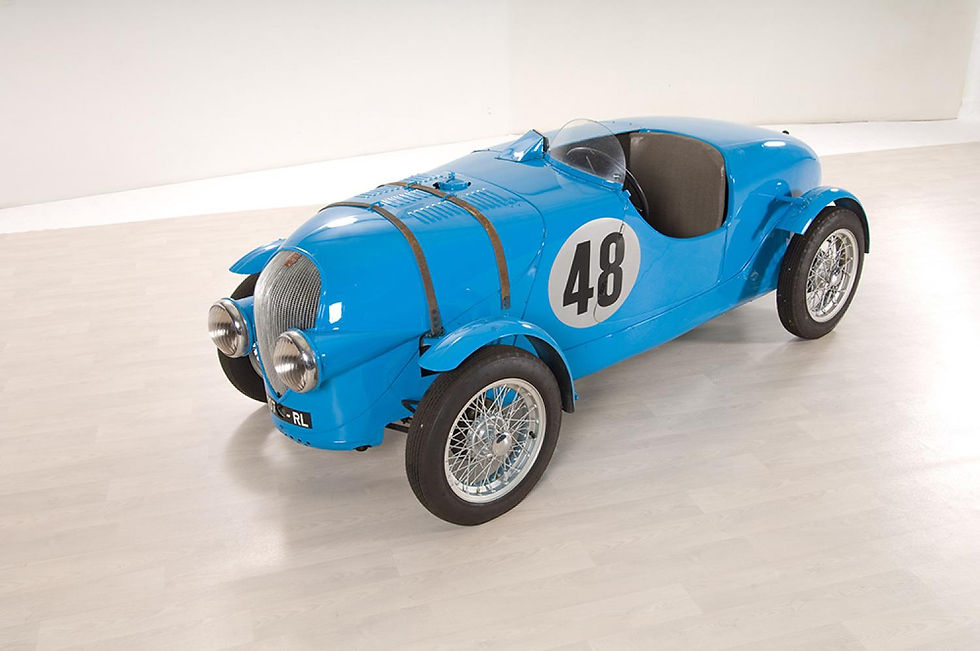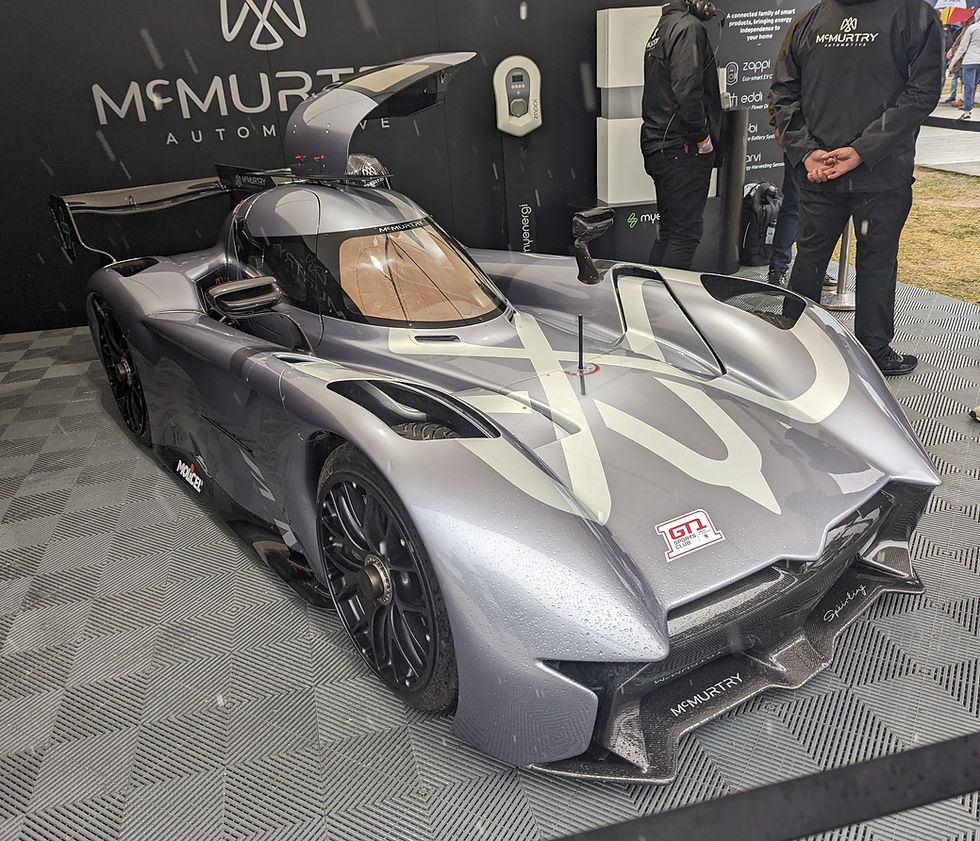The Simca 5 Gordini & 24 Hours of Le Mans
- KM Rental Cars
- Jul 29
- 4 min read
We publish the article in full:
With our "The Museum at Home" series, discover some cars or precious objects from the 24 Hours of Le Mans Museum. Twice a week, this emblematic place of the circuit presents its treasures to you. Today we reveal to you the story of the Simca 5 of the "wizard" Amédée Gordini.

It is to the talent of the immense Dante Giacosa that Italy owes the creation of the Fiat 500. This car had to be economical, according to the wishes of Gianni Agnelli, co-owner and director of Fiat. This car had to be able to be purchased by the workers who produced it. This "topolino" or "little mouse" in Italian was such a success that it was quickly imported to France by Simca who renamed it Simca 5. It is on this basis that Amédée Gordini, called "the sorcerer" as he was capable of technical feats on mass-produced mechanical bases (Fiat, then Simca), will develop the racing Simca 5. It is the smallest displacement to have been entered in the 24 Hours of Le Mans race, with its 568 cm3, it reached a top speed of 110 km/h, it will nevertheless achieve an average of 85 km/h (compare with the 92 km/h average of the Chenard and Walcker victorious in 1923). She won her category three consecutive years (1937,38,39), with a victory in the performance index in 1938.
In 1937 she finished last ranked but having covered almost 2000 kilometers with Jean Viale and Albert Alin. In 1938, the feat achieved by Maurice Aimé and Charles Plantivaux, with an index value of 1.280 for performance, having covered 2042.759 kilometers in 24 hours, just ahead of the sister car of Albert Leduc and Athos Querzola. In 1939, the two cars reached the finish with brothers Albert and Adrien Alin on the n°48 and Maurice Aimé and Albert Leduc on the n°49, in that order, neither having crossed this time the 2000 kilometer mark. Ten years later, the Simca 6, this time equipped with the same mechanics, will complete the 24 Hours of the post-war renaissance by covering 2,111,110 kilometers. The car, bearing the n°48, which appears in the collections of the Automobile Club de l'Ouest was offered by Amédée Gordini himself, probably close to President Jean Marie Lelièvre, the latter was particularly interested in the French manufacturers involved at the 24 Hours of Le Mans, like Charles Deutsch and René Bonnet.

Amédée Gordini's workshop, from which real jewels emerged, was then on Boulevard Victor in Paris, almost opposite the current Auto or Retromobile Show. The little Simca 5 from the ACO was restored a few years ago and the big surprise during disassembly was to see that the floor of the car is in fact Amédée's drawing board because it contains the sketches and millimeter dimensions of the car. At Amédée, nothing was lost, the proof..
Born at the very end of the 19th century in Italy, Amédée Gordini specialized in the Paris suburbs in the development and preparation of engines. He was also a competitor and won the Bol d'Or in 1935 and 1936 on Fiats before taking care of Simca, first the Simca 5 discussed above then the Simca 8 which distinguished itself with beautiful tray bodies, at the 24 Hours of Le Mans in 1939. After the war, he also turned to the construction of Grand Prix single-seaters at the wheel of which the French Jean Behra, Maurice Trintignant and Robert Manzon would shine. For this he ended his collaboration with Simca and he built his own engines whose displacements range from 1500 cm3 to 3000 cm3 for the sports boats that he fielded at the 24 hours of Le Mans, without much success (best performance 5th at the 24 Hours of Le Mans). The lack of financial resources does not allow it to carry out tests and the reliability of the mechanics suffers. However, he is the only representative of France at this international level of competition and subscriptions have been launched to help finance it. Gordini even imagined producing sports cars and presented one of his creations at the 1952 auto show, without a future. The adventure ended at the end of the 1956 Grand Prix season, despite a new car. In 1957, Amédée Gordini linked his destiny with Renault to whom he gave a rejuvenated and sporty image by offering sports derivatives of certain cars in the range (Dauphine, R8, R12, R17) while developing high-performance engines for Alpine. In 1967, Renault bought the Gordini brand which particularly contributed to the revival of French motorsport through the Gordini Cup, a veritable breeding ground for young talents. Amédée's engines will be landmarks, from the 1000 cm3, 1300 cm3 and even 1500 cm3, double camshafts, which will gain the performance index and the energy index in the Alpine prototypes at Le Mans, to the three-liter V8. liters which will equip the Alpine 24 Hours. Grafted with a turbo, the Alpine won the 24 Hours in 1978. Amédée Gordini died in 1979 at the age of 80.


SIMCA 5 specification:
Manufacturer | Simca-Gordini |
Model | Type 5 Sport |
Year of production | 1937 |
Start of production | 1937 |
End of production | 1939 |
Body type | roadster |
Number of doors | 2 |
Number of seats | 2 |
Engine position | front |
Drive wheel | rear |
Fuel | petrol |
Number of cylinders | inline 4 |
Cooling | liquid |
Capacity | 569 ccm, 34.6 cu-in |
Bore | 52.0 mm, 2.047 in |
Stroke | 67.0 mm, 2.638 in |
Compression ratio |
|
Valve Gear | SV |
Valves per cylinder | 2 |
Fuel system | carburator |
Aspiration | normal |
Max power [kW / PS / hp] | 17 / 23 / 23 |
Max torque [Nm / ft-lb] |
|
Total power (hybrid) |
|
Total torque (hybrid) |
|
Gearbox | M4 |
Gearbox (option) |
|
Wheelbase | 2000 mm, 78.7 in |
Front track | 1110 mm, 43.7 in |
Rear track | 1080 mm, 42.5 in |
Length |
|
Width |
|
Height |
|
Weight | 500 kg, 1102 lb |
Maximum speed | 125 km/h, 78 mph |




Comments